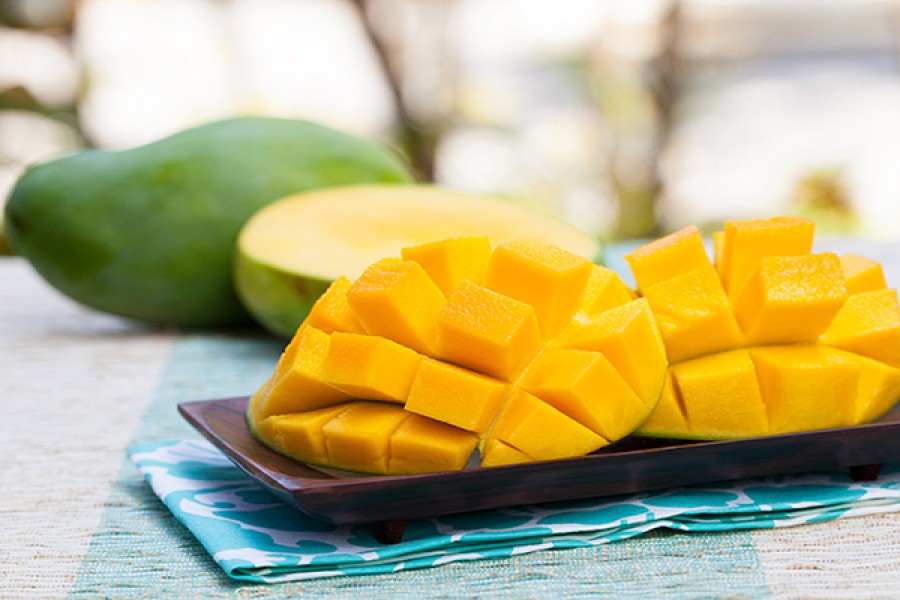The mango: a fleshy, oval, tropical fruit with a yellowish-red skin and hard stone in the middle, which is eaten ripe or used green in pickles and chutneys, says a BBC report.
There are hundreds – maybe thousands – of varieties of the fruit that never appear on our supermarket shelves. Here are more facts about the marvellous mango-
1. Mangoes are as diverse as apples or plums
There are hundreds and hundreds of varieties of mango, regional and distinct. Some creamy and sweet, some citrusy, some a bit hot, some like pineapple and some – often found in our supermarkets – just a bit bland. It’s worth seeking out the sweeter varieties if you can: give the Alphonso a try, according to the BBC report.
2. It is the national fruit of not one but three countries
The mango is the national fruit of Pakistan, India and the Philippines. It is also the national tree of Bangladesh, the report says.
3. The name “mango” originated in India
The English name mango is likely derived from the Tamil word mankay or Keralan word mangga. When Portuguese traders settled in Southern India, they adopted the name as manga, according to BBC.
It was as the British were trading with South India in the 15th and 16th Centuries that the word mango was born.
4. Over 43 million tonnes of mangoes are produced globally
Almost all of these are Tommy Atkins mangoes – a variety that grows quickly, has a great size and colour, is resistant to many types of fungus, doesn’t bruise easily, and will last a long time on a supermarket shelf. All these characteristics make it ripe for exporting around the world, the report says. Unfortunately, it is also stringy and relatively tasteless.
5. The UK's mangoes are sourced from all corners of the globe
UK supermarkets source mangoes from all around the world: Peru in the early part of the year, then west Africa, followed by Israel and Egypt in the third quarter and then Brazil, reports the BBC.
6. India is the world’s biggest producer of mangoes
The South Asian country produces over 18 million tonnes of the fruit, mostly for domestic consumption.
7. Mangoes were first grown in India over 5,000 years ago
The wild mango is thought to have originated in the foothills of the Himalayas in India and Myanmar. The first known cultivation of the fruit was around 5,000 years ago in Southern India, Myanmar, and the Andaman Islands (an archipelago in the Bay of Bengal), according to the report.
8. The oldest mango tree has been around for centuries
The oldest living mango tree is thought to be 300 years old and is found in East Khandesh in Central India, the BBC report says. Surprisingly, the ancient plant still produces fruit!
9. Mangoes were introduced to America in the early 20th Century
David Fairchild was an agricultural explorer for the US government at the turn of the 20th Century who was in India when he discovered the mango. Legend has it that he tried to ship a thousand mangoes back to his homeland but the boat’s captain said they were too heavy. He solved this problem by hiring a group of local children to eat all the fruit, in only a few minutes, leaving just the stones for transportation. Some of Fairchild’s early varieties are still growing today in South Florida, according to BBC.
10. The world’s heaviest mango was longer than a ruler
According to Guinness World Records, the heaviest recorded mango weighed 3.435 kg and measured 30.48 cm in length, 49.53 cm in circumference and 17.78 cm in width. The whopper was harvested from a tree in Sergio and Maria Socorro Bodiongan’s front garden in the Philippines in 2009.
11. Mangos are related to cashews and pistachios
A mango is a drupe: a fleshy fruit with a thin skin and a large, pithy central stone called an endocarp that contains the fruit’s seed. Olives, dates and cherries are drupes and, as nutty as it sounds, the cashew and pistachio also come from drupes, making them distant cousins of the mango, the BBC report says.
12. The mango is a sacred tree for Buddhists
It is said that Buddha meditated and rested with fellow monks in the peaceful tranquility of lush mango groves. As a result, the mango tree is considered holy within the Buddhist faith.
13. Mangoes are majorly good for you
One cup of mango contains about 60 mg of vitamin C. The NHS website recommends that adults aged 19-64 years old need 40mg of vitamin C a day! And the health benefits don’t stop there, according to BBC.
Mangoes contain over twenty different vitamins and minerals: they are high in vitamin A, potassium, folate – and also provide a solid serving of fibre. Guilt-free feasting!


